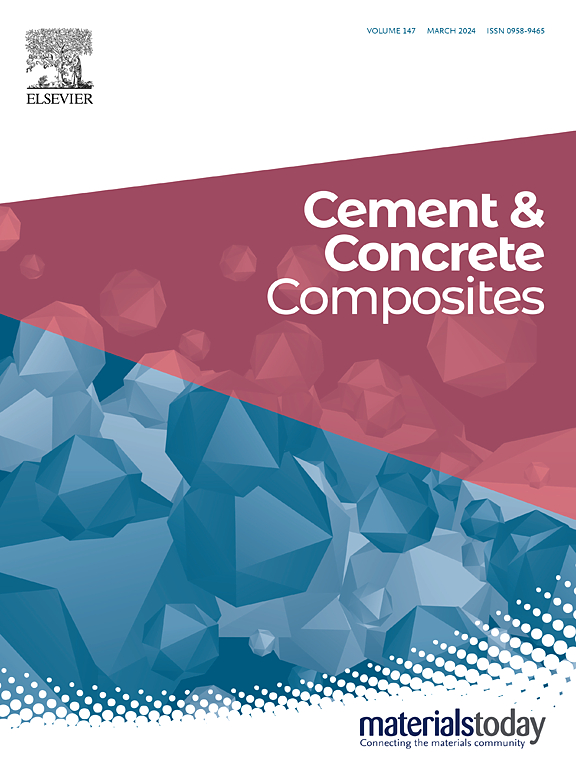一种新型水泥-粉煤灰-碳化钢渣三元固碳胶凝体系
IF 10.8
1区 工程技术
Q1 CONSTRUCTION & BUILDING TECHNOLOGY
引用次数: 0
摘要
本工作介绍了一种名为CFCS的创新胶凝体系,该体系将水泥、粉煤灰(FA)和碳化钢渣(CS)结合在一起,具有较高的早期和后期抗压强度,同时显著降低了碳排放。这是通过二氧化碳辅助湿磨从钢渣(SS)中生产高活性硅胶和固碳碳酸钙(Cc)来实现的。结果表明,CFCS在1 d和28 d时的抗压强度较水泥- fa -石灰石(CFL)体系分别提高了26%和34%。CFCS的优异早期性能归因于CS中硅胶的高火山灰反应性,这有利于形成额外的硅酸钙水合物(C-S-H)凝胶。此外,活性Cc很容易与铝酸盐反应形成单碳酸酯(Mc)。这些凝胶作为成核位点,促进水泥水化程度的提高,有利于早期强度的发展。CS诱导的水泥加速水化为粉煤灰(FA)的高反应度创造了有利的环境,使得后期抗压强度持续提高。与普通硅酸盐水泥相比,CFCS的减碳量可达64%左右,是一种超低碳胶凝体系。本文章由计算机程序翻译,如有差异,请以英文原文为准。
An innovative ternary carbon-fixing cementitious system of cement-fly ash-carbonated steel slag
The present work introduced an innovative cementitious system named CFCS, combining cement, fly ash (FA), and carbonated steel slag (CS), which exhibited both high early and later-age compressive strength along with significantly lower carbon emissions. This was achieved by producing highly reactive silica gels and carbon-fixing calcium carbonates (Cc) from steel slag (SS) via CO2-assisted wet grinding. The results indicate that CFCS shows remarkable improvements in compressive strength, about 26 % and 34 % higher compared to the system of cement-FA-limestone (CFL) at 1 d and 28 d, respectively. The superior early performance of CFCS is attributed to the high pozzolanic reactivity of silica gels in CS, which facilitates the formation of additional calcium-silicate-hydrate (C-S-H) gels. Additionally, reactive Cc readily reacted with aluminates to form monocarbonate (Mc). These gels act as nucleation sites, promoting a higher cement hydration degree and contributing to early strength development. The accelerated cement hydration induced by CS creates a favorable environment for the higher reaction degree of fly ash (FA), resulting in sustained enhancement of compressive strength at later stages. Moreover, the carbon reduction of CFCS can reach about 64 % compared to ordinary Portland cement, representing an ultra-low carbon cementitous system.
求助全文
通过发布文献求助,成功后即可免费获取论文全文。
去求助
来源期刊

Cement & concrete composites
工程技术-材料科学:复合
CiteScore
18.70
自引率
11.40%
发文量
459
审稿时长
65 days
期刊介绍:
Cement & concrete composites focuses on advancements in cement-concrete composite technology and the production, use, and performance of cement-based construction materials. It covers a wide range of materials, including fiber-reinforced composites, polymer composites, ferrocement, and those incorporating special aggregates or waste materials. Major themes include microstructure, material properties, testing, durability, mechanics, modeling, design, fabrication, and practical applications. The journal welcomes papers on structural behavior, field studies, repair and maintenance, serviceability, and sustainability. It aims to enhance understanding, provide a platform for unconventional materials, promote low-cost energy-saving materials, and bridge the gap between materials science, engineering, and construction. Special issues on emerging topics are also published to encourage collaboration between materials scientists, engineers, designers, and fabricators.
 求助内容:
求助内容: 应助结果提醒方式:
应助结果提醒方式:


